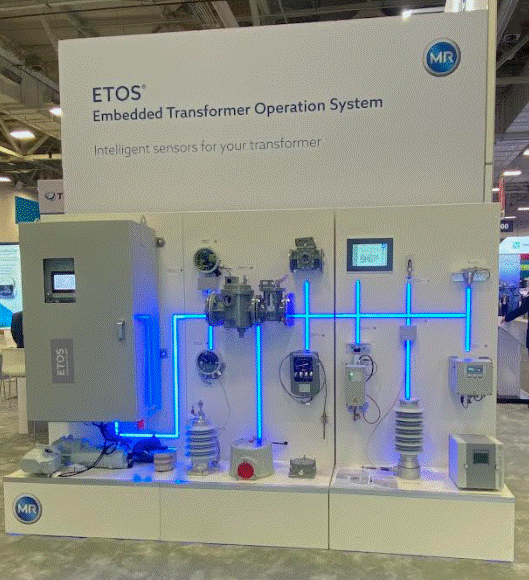Facing dual pressures of 1) integrating distributed, renewable sources and 2) managing aging infrastructure, the electrical grid is in immense transformation.
When it comes to transformers—one of the industry’s most critical pieces of equipment, given supply constraints and expected load growth—MR Reinhausen took to DistribuTECH 2025 to share its decades of experience and cutting-edge innovation to meet these challenges head-on. We spoke with Brandon McCrary, Sales Manager in MR Reinhausen’s Industrials, Renewables, & Data Centers division, to dive into the specifics of transformer modernization.
Beginning with advanced digitalization tools which allow implementation of predictive maintenance strategies, modernizing transformer technology to build a more resilient and efficient grid comes with a host of options in the toolbelt. “The transformer is the heart of the grid,” McCrary said. “If we don’t modernize it, the rest of the grid can’t evolve either.”
The Grid’s Growing Demands on Transformer Technology
The rapid adoption of renewable energy sources across the grid, coupled with massive, centralized load growth (such as Data Centers), has introduced new complexities for grid stability and voltage regulation. The more renewable energy sources, like solar and wind connected the grid, the more weight placed on the system’s transformers to handle dynamic and fluctuating loads. This evolution makes traditional approaches to managing this infrastructure insufficient.
MR Reinhausen aims to tackle this issue with solutions designed to extend the lifespan of transformers while optimizing their performance. Rather than requiring costly and time-consuming replacements of aging transformers, their approach focuses on smarter retrofitting and refurbishment strategies. “You can’t just replace every aging transformer,” McCrary said. “We need smarter ways to optimize existing assets, smarter ways to modernize our fleets.” This approach ensures utilities can meet renewable energy integration challenges without compromising grid reliability.
Digitalization and Predictive Maintenance
The best way to get the most juice out of existing infrastructure like transformers is to prioritize maintenance. MR Reinhausen does this by leaning into the digitalization of transformer monitoring and predictive maintenance strategies. Using advanced tools like their ETOS platform, utilities can track transformer health in real time, gathering valuable data that supports proactive decision-making. Sensors can detect anomalies, including advanced insights like subtle changes in mechanical sounds, vibrations, and temperature within the transformer to get ahead of potential failures.
In many ways, digitalization enables utilities to embrace predictive maintenance, a game-changer for grid operators. Instead of reacting to unexpected breakdowns, utilities can move to instead prevent issues from arising altogether. Through asset intelligence algorithms and machine learning, MR Reinhausen’s systems analyze patterns and interdependencies in the data, uncovering insights that were previously hidden. “With digitalization, utilities can move from reactive maintenance to a proactive approach—saving time, money, and reducing unplanned outages,” McCrary said, noting that this shift not only improves reliability but also significantly reduces costs over the lifetime of the asset.
Innovations in Load Tap Changers (LTCs) and Regulation Technology
Load tap changers (LTCs), essential components for voltage regulation in transformers, have been a focus for McCrary and his team for years. MR Reinhausen has been making LTC’s for almost 100 years. It is estimated that more than 50% of the worlds power flows through a Reinhausen LTC. More recent innovations, however, are taking this technology to the next level, improving efficiency and reducing wear and tear. For example, McCrary noted how MR Reinhausen’s LTC solutions address real-world challenges, such as ensuring stable voltage levels even as renewable energy integration increases.
“Load tap changers are often overlooked, but they are key to keeping voltage stable in an increasingly dynamic grid,” McCrary pointed out, stressing the importance of reliable LTCs in modern energy systems. The company has also developed new materials and engineering approaches to reduce maintenance requirements and extend equipment lifespans.
The Future of Transformer Technology
Looking ahead, MR Reinhausen is positioning itself to address emerging grid challenges, from the rise of electric vehicle charging and centralized data center loads, to the growing prevalence of decentralized energy resources. These trends are driving the need for more sophisticated transformer technologies that can operate effectively – both at the bulk power transmission level, and at the grid edge. By focusing on interoperability and open platforms, MR Reinhausen ensures its technology integrates seamlessly with other systems, giving customers the flexibility to implement best-in-class solutions.
“The grid is evolving, and transformer technology needs to evolve with it. The industry can’t afford to stand still,” McCrary said. His vision is for a future where utilities fully leverage the potential of digitalization to create smarter, more resilient grids. And transformers will play a critical role in that future grid for the foreseeable future. “Modernizing transformers isn’t just about keeping the lights on,” he added. “It’s about preparing the grid for the future of energy.”
All week, Energy Central is publishing our series of conversations from DistribuTECH 2025. You can see them all as they go live at this landing page.
Other published interviews:










